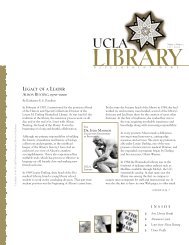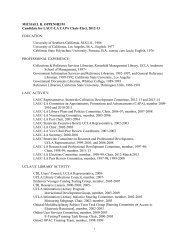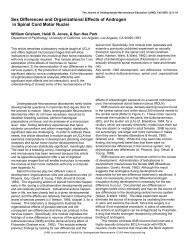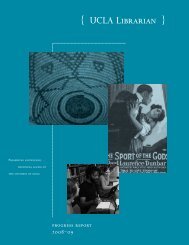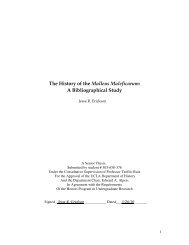Research Paper - UCLA Library
Research Paper - UCLA Library
Research Paper - UCLA Library
You also want an ePaper? Increase the reach of your titles
YUMPU automatically turns print PDFs into web optimized ePapers that Google loves.
Gu 31<br />
utilizing the phoenix metaphor in order to bolster the new king’s reputation amongst the English<br />
people. Hooke writes:<br />
For when the rare Phoenix of the world, the queene of bird,… was now through<br />
age to be turned into dust and ashes, though she appeared unto men to die, yet she<br />
died not, but was revived in one of her owne blood; her age renewed in his<br />
younger yeeres; her aged infirmities repaired in the perfection of his strength; her<br />
vertues of Christianitie and princely qualitie rested on him, who stood up a man as<br />
it were out of the ashes of a woman. 10 (Perry 156-7)<br />
The conversion of female to male modifiers reflects the linguistic project to reconvert the<br />
rhetoric of queenship back to one of a masculine monarch. Hooke’s description emphasizes the<br />
shifting of gendered language by repeating the “her” to “his” pattern in his comparisons between<br />
the phoenix and its progeny. James, “who was revived in one of [Elizabeth’s] owne blood,” is<br />
reborn with the qualities of Elizabeth. As John Watkins observes, “The phoenix trope asserted<br />
not just continuity but absolute identity between the regimes. Since poets and painters had long<br />
associated Elizabeth with the phoenix, the compliment’s application to James reinforced their<br />
claims that he was himself the deceased queen reincarnate” (Watkins 18). Hooke not only<br />
endows James with Elizabeth’s virtues, but also hints that the new king will heal or “repair”<br />
some of the riffs caused by the problems of the Queen’s final decade. By characterizing James in<br />
this way, Hooke is able to provide the sovereign with legitimate authority without burdening him<br />
with the faults of his predecessor.<br />
Thus, the regenerative properties of the phoenix trope proved beneficial to early Jacobean<br />
imagery and the symbolic value of the phoenix image made it particularly useful to Shakespeare<br />
10 From Henry Hooke, A Sermon Preached Before the King at White-Hall, the Eight of May, 1604… Jerusalems<br />
Peace (London, 1604), sigs. C2v-C3 (quoted in Perry, The Making of Jacobean Culture).



